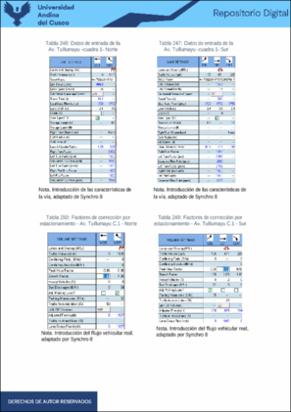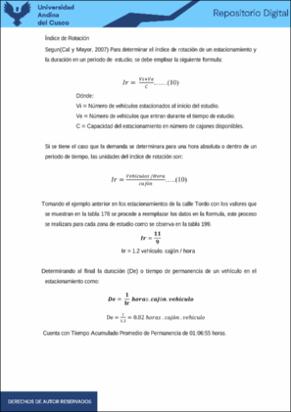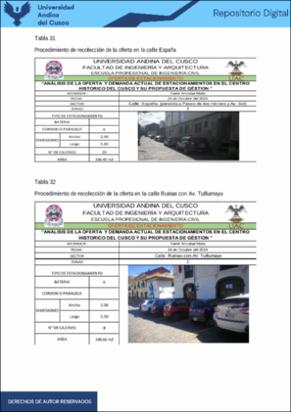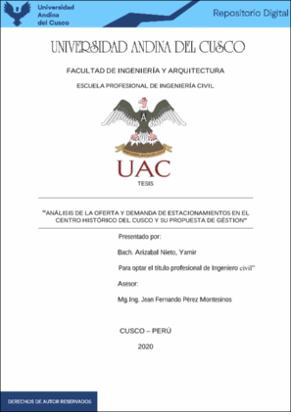| dc.contributor.advisor | Pérez Montesinos, Jean Fernando | |
| dc.contributor.author | Arizabal Nieto, Yamir | |
| dc.date.accessioned | 2021-06-22T21:02:08Z | |
| dc.date.available | 2021-06-22T21:02:08Z | |
| dc.date.issued | 2020-12-30 | |
| dc.identifier.uri | https://hdl.handle.net/20.500.12557/3930 | |
| dc.description.abstract | El Centro Histórico del Cusco no cuenta con información actual de la Oferta y Demanda de
estacionamientos en la vía , para lo cual el presente trabajo de investigación tiene el objetivo
de analizar la cantidad de cajones disponibles en la vía para el estacionamiento de vehículos y
la demanda de estacionamientos que se presenta en el centro de la ciudad , el desarrollo de la
investigación inicio con la obtención de 20 sectores que cuentan con estacionamiento en la vía,
se procedió la recolección de datos de cada una de estas mediante guías de observación que
facilitaron la determinación de la oferta actual obteniendo un total de 539 cajones disponibles
y la para determinación de la Demanda se realizó un registro de placas de lunes a viernes para
así determinar que el día lunes es en el cual se produce la mayor demanda de estacionamientos,
se comparó por sectores los resultados, obteniendo el déficit entre demanda y oferta de
estacionamientos concluyendo que la demanda supera altamente a la oferta actual, también se
procedió a realizar un conteo vehicular para obtener el flujo vehicular que se produce el día
Lunes con la finalidad de determinar si el estacionamiento presente disminuye la capacidad vial
de las zonas en estudio para ello se empleó el Software Synchro 8 para la simulación del tráfico
y la determinación de la capacidad vial y volumen vehicular ajustado que siguiente la
metodología presentada en el marco teórico se relacionó ambos resultados y así obtener el nivel
de servicio de cada sector analizado obteniendo que el estacionamiento afecta a la calidad de
todas las vía y de los 20 sectores analizados 17 de ellos poseen un nivel de servicio aceptable
por lo cual es factible la conservación del estacionamiento y 3 de ellos cuenta con un nivel de
servicio “F” el cual implica la reconsideración de la conservación del estacionamiento, por otro
lado al realizarse encuestas sobre la finalidad del estacionamiento se logró obtener que el centro
historio alberga todo tipo de actividades siendo la más comunes las de turismo y comercio ,
esta información y a partir de los resultados obtenidos fueron la base para buscar una alternativa
sustentable que solucione a corto y largo plazo la disponibilidad de estacionamientos , optando
por implementar sistemas de parquímetro en los estacionamientos existentes o realizar un
convenio con los estacionamientos privados y construir edificios de estacionamientos , siendo
la alternativa a largo plazo la más adecuada que consta de implementar el cobro de una tarifa
por congestión al ingresar en el centro histórico el cual no solo mitigaría la congestión vehicular
sino que incentivaría nuevos modos de transporte y controlaría la demanda de estacionamientos. | es_PE |
| dc.description.abstract | The Historic Center of Cusco does not have current information on the Supply and Demand of
parking on the road, for which the present research work has the objective of analyzing the
number of boxes available on the road for parking vehicles and the demand of parking lots that
occur in the center of the city, the development of the research began with the obtaining of 20
sectors that have parking on the road, the data collection of each of these was proceeded through
observation guides that facilitated the Determination of the current supply obtaining a total of
539 available spaces and to determine the Demand, a registration of plates was made from
Monday to Friday in order to determine that Monday is the day when there is the greatest
demand for parking, it was compared by sectors the results, obtaining the deficit between
demand and supply of parking, concluding that the demand exceeds ltly to the current offer, a
vehicle count was also carried out to obtain the vehicle flow that occurs on Monday in order to
determine if the current parking decreases the road capacity of the areas under study, for this
the Synchro Software was used 8 for the traffic simulation and the determination of the road
capacity and adjusted vehicular volume that following the methodology presented in the
theoretical framework related both results and thus obtain the level of service of each analyzed
sector, obtaining that parking affects the quality of All the roads and of the 20 sectors analyzed,
17 of them have an acceptable level of service, for which it is feasible to conserve the parking
lot and 3 of them have a level of service “F” which implies the reconsideration of the
conservation of the parking lot. On the other hand, when surveys were conducted on the purpose
of parking, it was possible to obtain that the center historic all kinds of activities, the most
common being tourism and commerce, this information and from the results obtained were the
basis for seeking a sustainable alternative that solves the availability of parking in the short and
long term, opting to implement parking meter systems in existing parking lots or make an
agreement with private parking lots and build parking buildings, the long-term alternative being
the most appropriate which consists of implementing the collection of a congestion fee when
entering the historic center which would not only mitigate the traffic congestion but would
encourage new modes of transportation and control the demand for parking. | en_US |
| dc.description.uri | Tesis | es_PE |
| dc.format | application/pdf | es_PE |
| dc.language.iso | spa | es_PE |
| dc.publisher | Universidad Andina del Cusco | es_PE |
| dc.rights | info:eu-repo/semantics/openAccess | es_PE |
| dc.rights.uri | https://creativecommons.org/licenses/by-nc-nd/2.5/pe/ | es_PE |
| dc.source | Universidad Andina del Cusco | es_PE |
| dc.source | Repositorio Institucional UAC | es_PE |
| dc.subject | Oferta y demanda de estacionamientos | es_PE |
| dc.subject | Capacidad vial | es_PE |
| dc.subject | Volumen vehicular | es_PE |
| dc.subject | Tarifa de congestión | es_PE |
| dc.title | Análisis de la oferta y demanda de estacionamientos en el Centro Histórico del Cusco y su propuesta de gestión | es_PE |
| dc.type | info:eu-repo/semantics/bachelorThesis | es_PE |
| thesis.degree.name | Ingeniero Civil | es_PE |
| thesis.degree.grantor | Universidad Andina del Cusco. Facultad de Ingeniería y Arquitectura | es_PE |
| thesis.degree.level | Titulo Profesional | es_PE |
| thesis.degree.discipline | Ingeniería Civil | es_PE |
| dc.publisher.country | PE | es_PE |
| dc.subject.ocde | https://purl.org/pe-repo/ocde/ford#2.01.01 | en_US |
| renati.advisor.dni | 40996443 | |
| renati.advisor.orcid | https://orcid.org/0000-0002-7566-1001 | en_US |
| renati.author.dni | 74079109 | |
| renati.discipline | 732016 | |
| renati.juror | Zevallos Guzman, Herbert Jesus | |
| renati.juror | Mendoza Escalante, Camilo | |
| renati.juror | Chura Cortez, Cesar Augusto | |
| renati.juror | Chipana Molina, Yimmy Johan | |
| renati.level | https://purl.org/pe-repo/renati/level#tituloProfesional | es_PE |
| renati.type | https://purl.org/pe-repo/renati/type#tesis | es_PE |





